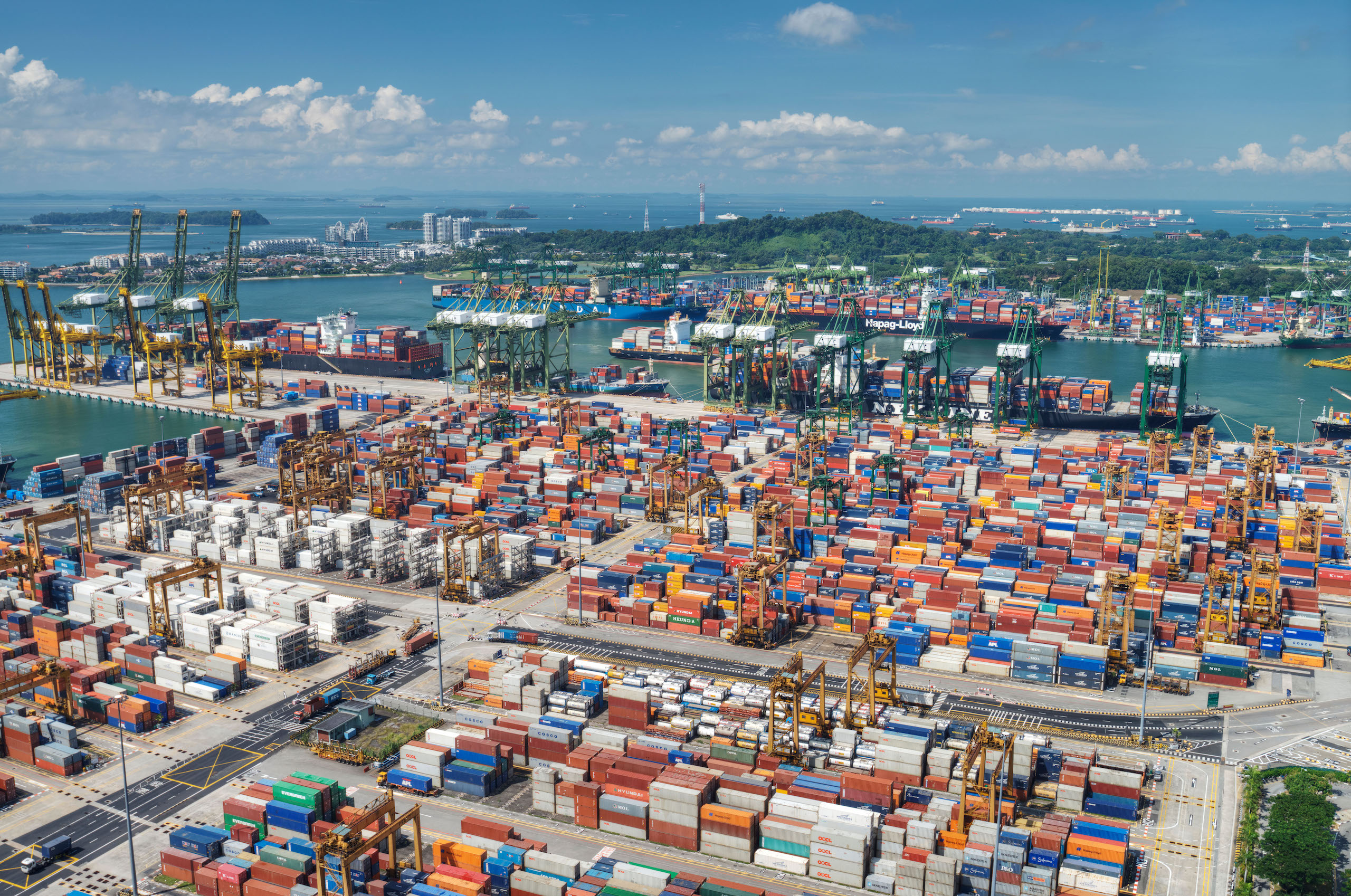The world’s first global carbon price is getting closer to becoming a reality.
At a March meeting of the UN International Maritime Organisation (IMO) in London, a majority of member states expressed support for a levy on greenhouse gases emitted by the global shipping industry.
This fee – along with a fuel standard mandating that ships must increase the proportion of green energy they are using over time – could upgrade the backbone of global trade to zero-carbon technology. But first, it must make it safely through some challenging political waters at the UN agency.
In a statement issued by the civil society group Clean Shipping Coalition after the IMO meeting, Sandra Chiri of the Ocean Conservancy said: “The UN is on the edge of adopting the world’s first-ever global emissions price, but the policy will only be as successful as countries make it to be.
“The March talks at the IMO gave us hope that a clear majority of countries – the Caribbean, the Pacific, Africa, but also the EU and Canada – understand the huge opportunity of pricing shipping emissions for the industry’s clean transition and for making sure this transition benefits all developing countries. It’s regrettable that a small but persistent minority strives to water down this vital climate measure.”
The IMO runs on a consensus basis, but the chair has the power to overrule holdouts if a large majority of countries are on board with a given decision.
Why shipping is a big deal for the climate
According to the UN, shipping carries about 80% of global trade: from containerships full of consumer goods, to oil tankers carrying crude and gasoline, and bulk cargo ships carrying coal, iron ore and grains. Shifting this much stuff around requires a lot of energy.
Approximately 60,000 cargo ships are operating in international waters. Currently, they all burn fossil fuels, and most of that is heavy fuel oil (HFO), made from the dregs of the oil refining process. Shipping gulps up 5% of global oil demand and emits greenhouse gases (GHG) equivalent to more than a billion tonnes of CO2 every year. If this industry was a country, it would be among the top 10 global emitters.
Over the decades, some progress has been made on cleaning up the industry, via tougher standards for new ships, reduction of pollutant levels in fuel, and some monitoring of operations efficiency. For example, speed reduction is currently one of the main strategies, because it does not require new fuels or infrastructure.
But governments have recognised they need to go much further to reduce net greenhouse gas emissions down to nothing – which scientific consensus says is necessary to preserve a liveable climate system. Last July, IMO member states agreed a strategy to reduce shipping emissions by “20% (striving for 30%)” by 2030, and to reach zero emissions “by or around” 2050.
How to achieve these ambitious goals is the key question. At March’s IMO meeting, member states agreed the answer was “a new global fuel standard and a new global pricing mechanism for maritime GHG emissions”. Tougher efficiency rules are also on the cards.
The IMO is on track to settle these details in early 2025 and adopt them later that year. The rules would come into force in 2027 via an amendment to the International Convention for the Prevention of Pollution from Ships (MARPOL), which would dictate compliance across the world. Several nations have already established domestic or regional carbon markets, but a fuel levy on shipping would become the first pricing mechanism for GHG emissions that applies globally.
MARPOL is a set of rules and regulations that most of the International Maritime Organisation’s 175 member states have ratified. It is a powerful, globe-spanning tool that operates outside the control of any one country.
Even if a ship docks in a country that has not ratified this convention, the ship must still comply, because it would otherwise lose its safety certification. Without this certification, a ship cannot be insured, and bank loans cannot be accessed – both of which are essential for shipping.
At present, however, though there is still much disagreement on the design of such a system and where to set the starting price.
What price is right?
Currently, it makes no economic sense for shipowners to switch to buying green fuels, such as hydrogen or ammonia produced using renewable energy. Fossil fuel for ships is much cheaper and, unlike green fuels, tax-free. Clean energy think-tank Rocky Mountain Institute (RMI) believes green-hydrogen-produced ammonia could cost USD 1,239 per tonne of fuel oil equivalent in 2030. That would be just under double the current equivalent fossil fuel price of approximately USD 700.
These figures would necessitate that a fossil fuel levy be set at USD 130-180 per tonne of emitted CO2 to close the price gap between green and polluting fuel. Meanwhile, the commodity trading giant Trafigura suggests USD 250-300 a tonne is needed.
The shipping industry itself, represented by the International Chamber of Shipping (ICS), is cagey on the exact price it wants. In 2022, its secretary-general Guy Platten said USD 50-100 “could well be viable”.
Nations are also far apart on this issue: ahead of the IMO’s meeting in March, a coalition of eight Pacific and Caribbean island states called for a starting price of USD 150, while in 2022, Japan proposed a starting price of USD 56 in 2025, to rise significantly every five years.
Carbon prices in other sectors vary hugely. According to World Bank data collated in 2023, one of the world’s highest existing CO2 levies is the fossil combustible fuels levy in Switzerland, set at CHF 120 (USD 131) in 2022.
Where should the money go?
The Getting to Zero Coalition is a club of climate-ambitious shipping companies. It estimates that decarbonising the sector will require an investment of between USD 70-90 billion per year from 2030 until 2050. Most of this would be needed to build green fuel production plants on land, with only 12% spent on upgrading ships.
Many ships being ordered or built today are already designed to be “dual-fuel” – capable of running on both fossil and green fuels. The latter is most often methanol, but sometimes green ammonia. (Ammonia still has sustainability issues surrounding reactive nitrogen emissions that need tackling, leading some industry players to advocate for green hydrogen instead.) Providing green fuel subsidies funded by a fossil fuel levy would help these dual-fuel ships to transition.
Revenue from this levy could also retrofit tens of thousands of suitable vessels with wind-propulsion technologies. This could reduce CO2 emissions faster in the short-term, and achieve a greater emissions reduction per dollar of investment.
Brazil, China, Norway and UAE argue that instead of a universal levy on each tonne of emissions, only the most polluting ships ought to be penalised with a fee. Under their proposal for an International Maritime Sustainable Fuels and Fund mechanism, the baseline for a fuel’s GHG intensity would be set each year. Ships using a more carbon-intensive fuel mix would have to pay into this mechanism, while those using less carbon-intensive fuels would receive the money raised. This “flexible compliance” mechanism would also allow carbon credit trading between the most and least polluting ships, and “banking” of surplus credits to use the next year.
Environmental experts are concerned that building these “flexible compliance” options into the regulation would do little to incentivise the uptake of genuinely zero-emissions fuels. In the short-term at least, it could incentivise the use of biofuels and fossil-fuel derived hydrogen (which have questionable environmental credentials), rather than renewable energy-produced fuels.
Brazil and China’s proposal envisions raising only USD 1-2 billion per year in revenues, which would not in itself generate sufficient revenue to pay for shipping’s clean energy transition.
It is also less ambitious than much of the industry’s stance: the ICS is pushing for a per-tonne-of-emissions levy on all shipping, while the Getting to Zero Coalition wants levy revenue to be spent on zero-emission and near-zero fuels only.
Sharing the wealth beyond shipping
Some countries want to see the levy revenues spread beyond the shipping sector, to boost green fuel production, fund research and development, or even help countries improve their resilience to climate change.
Many Small Island Developing States (SIDS) and Least Developed Countries (LDCs) argue the billions raised by a shipping levy cannot be hoarded by the countries that currently dominate ship ownership and shipbuilding – it must be available to all. At COP28, for example, the Marshall Islands argued that “the polluter-pays principle… requires that the majority of any revenues generated from pricing [shipping] GHG emissions should be directed to addressing those climate impacts in developing countries, particularly SIDS and LDCs.”
China has objected to the use of shipping levy revenues for climate change-related finance beyond the sector. It argues this would absolve wealthy nations of their historic responsibilities to pay into the Paris Agreement’s Loss and Damage fund. Pacific Island states disagree, saying any climate finance raised from shipping must be entirely separate and additional to that fund.
What’s in it for business?
Concerns over the economic impacts of regulating shipping continue to be raised by China and other large, developing economies. A study by Brazil’s University of São Paulo found a carbon tax on shipping could reduce GDP in non-OECD developing countries by 0.13% versus a do-nothing baseline, with Africa and South America especially affected.
On the other hand, IMO regulation capable of reducing shipping emissions around 20-30% by 2030 is considered a big economic opportunity by some industry players. The largest independent oil tanker firm, Euronav, has announced plans to buy 120 zero-carbon vessels, powered by hydrogen and ammonia. Meanwhile, competition is intensifying between Chinese and Korean shipyards for contracts to build methanol-ready ships.
China is already a leader in green shipping technologies, such as battery-powered ships and green hydrogen.
The China Ocean Shipping Company (COSCO), Shanghai Port Group and two other state-owned companies have agreed to develop a green methanol supply chain in China. Meanwhile, the Chinese clean energy producer GoldWind has signed a deal to sell 500,000 tonnes of green methanol annually to the Danish shipping company Maersk.
But the country needs global climate regulations on shipping to scale up such businesses – the type of regulations its container shipping companies and conventional fuel producers want to avoid.
China’s 14th five-year plan (2021-2025) includes a major focus on port electrification and reducing GHG emissions along inland waterways. The question now is whether the 15th five-year plan, due to be unveiled in 2025, will expand this to other shipping activities.
Hongming Liu, the director of carbon markets at the Environmental Defence Fund in Beijing, is optimistic. “It will be the last five-year plan before carbon peaking by 2030. We think green shipping should at least be considered,” he says. “I believe China can supply at least part of the shipping sector’s needs on green fuels in the future.”
If the IMO now fails to adopt a levy, or sets a weak price, it will put such investments at risk. There are big decisions to make – and less than a year to make them – if shipping is to stay on course to meet its Paris Agreement-aligned goals.











